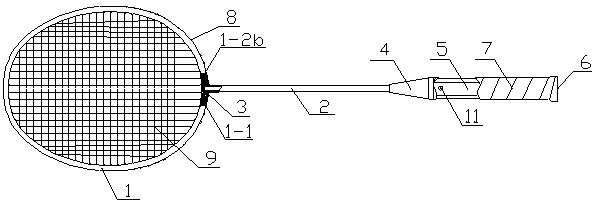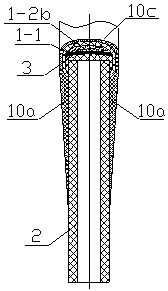Badminton racket and manufacturing method thereof
A badminton racket and racket technology, which is applied in the field of sports equipment, can solve the problems of large swing wind resistance, increased force-bearing area, and small direct force-bearing area, etc., and achieves improved hitting stability, reduced vibration, and improved racket hitting feeling. clear effect
- Summary
- Abstract
- Description
- Claims
- Application Information
AI Technical Summary
Problems solved by technology
Method used
Image
Examples
Embodiment
[0123] A method for manufacturing badminton rackets, which takes the following steps to achieve
[0124] 1. The method of coating foamed resin 1-2a on lightweight non-woven shock-absorbing fiber cloth 1-1 is as follows:
[0125] (1) Blending foam resin
[0126] The main components of the foamed resin are: bisphenol A epoxy resin, natural rubber, PU foam powder, and methyl ethyl ketone solvent. The weight ratio is:
[0127] Bisphenol A epoxy resin 4~9
[0128] Natural rubber 12~18
[0129] PU foaming powder 38~50
[0130] Methyl ethyl ketone solvent 28~35
[0131] The above-mentioned materials are all commercially available materials.
[0132] (2) Use a fully automatic coating machine to uniformly coat the formulated foamed resin on one side of the lightweight non-woven shock-absorbing fiber cloth according to the thickness of 0.20-3mm, and dry it to make a foamed resin coated cloth for use.
[0133] The thickness of the lightweight non-woven shock-absorbing fiber cloth is less than 3mm.
[01...
PUM
| Property | Measurement | Unit |
|---|---|---|
| depth | aaaaa | aaaaa |
| width | aaaaa | aaaaa |
| height | aaaaa | aaaaa |
Abstract
Description
Claims
Application Information
 Login to View More
Login to View More - R&D
- Intellectual Property
- Life Sciences
- Materials
- Tech Scout
- Unparalleled Data Quality
- Higher Quality Content
- 60% Fewer Hallucinations
Browse by: Latest US Patents, China's latest patents, Technical Efficacy Thesaurus, Application Domain, Technology Topic, Popular Technical Reports.
© 2025 PatSnap. All rights reserved.Legal|Privacy policy|Modern Slavery Act Transparency Statement|Sitemap|About US| Contact US: help@patsnap.com



